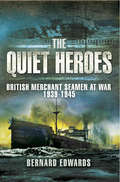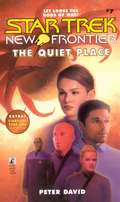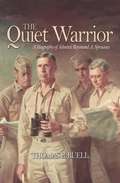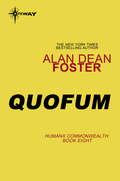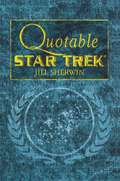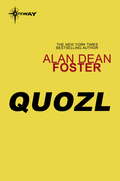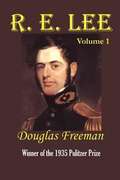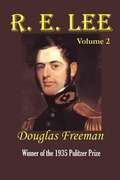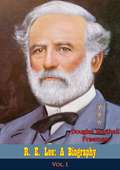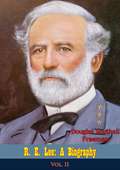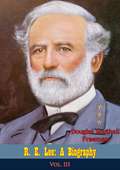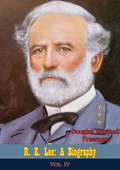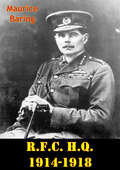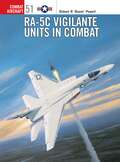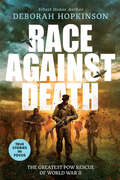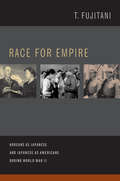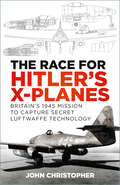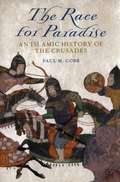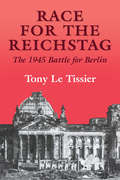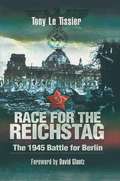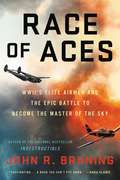- Table View
- List View
Quiet Heroes: British Merchant Seamen at War, 1939–1945
by Bernard EdwardsThe men of Britain's Merchant Navy, although unarmed civilians going about their lawful business were the first to be involved with the enemy in the Second World War. Less than nine hours after the declaration of war on 3 September 1939, the Donaldson liner Athenia was sunk without warning by a German U-boat off the west coast of Ireland. From that moment onwards, British merchant seamen were constantly in the front line in all quarters of the globe. For almost six years they faced, without flinching, their own private hell of torpedoes, bombs, shells and mines, all the while fending off their old arch-enemy, the sea. Sorely pressed, and often tired near to death, they kept open Britain's tenuous lifelines, bringing millions of tons of raw materials, food, oil, arms and ammunition, without which the country could not have survived. As always, their spirit was indomitable, their professionalism unchallenged. The price they paid for their bravery and dedication was horrendous: 2,246 ships lost, 29,180 men killed, and countless hundreds maimed and wounded. This book tells the story of just a few of these quiet heroes.
A Quiet Life: A Novel (Vmc Ser. #488)
by Beryl BainbridgeSeventeen-year-old Alan can't stand rows. But, though the Second World War has ended, peace hangs by a fine thread at home: his troublesome sister Madge creeps off for night-time liaisons with a German POW; their ineffectual father - broken by the hardships of war and an unhappy marriage - can't put food on the table despite the family's middle-class manners.Meanwhile, his mother pursues her escapist fantasies in romantic novels and love affairs. Obedient, faithful Alan is trapped among them all, the focus of their jibes and resentment, as inexorably the family heads towards disaster. Beryl Bainbridge's classic early novel is a vintage story of English domestic life, laced with sadness, irony and wicked black humour.'One of the best novelists of her generation' - Guardian.
A Quiet Life: A Novel (Virago Modern Classics #36)
by Beryl BainbridgeSeventeen-year-old Alan can't stand rows. But, though the Second World War has ended, peace hangs by a fine thread at home: his troublesome sister Madge creeps off for night-time liaisons with a German POW; their ineffectual father - broken by the hardships of war and an unhappy marriage - can't put food on the table despite the family's middle-class manners.Meanwhile, his mother pursues her escapist fantasies in romantic novels and love affairs. Obedient, faithful Alan is trapped among them all, the focus of their jibes and resentment, as inexorably the family heads towards disaster. Beryl Bainbridge's classic early novel is a vintage story of English domestic life, laced with sadness, irony and wicked black humour.'One of the best novelists of her generation' - Guardian.
The Quiet Place (Cold Equations #7)
by Peter DavidEver since the fall of the Thallonian Empire, Si Cwan has been searching for his younger sister, the only other survivor of the royal family. His quest has been a hard one, filled with many disappointments, but now it may be nearing its end.... On the planet Montos, a mysterious young woman, whose past is shrouded in secrecy, finds herself pursued by both the fanatical Redeemers and a vicious race of feral predators known only as the Dogs of War. All are in search of information regarding the true nature and location of the Quiet Place, a mystical realm celebrated in myth and legend. Only this same woman, now called Riella, may hold the secret of the Quiet Place, a secret that the Redeemers and others will kill to possess. Is Riella indeed Si Cwan's long-lost sister? Before he can learn the truth, he and his crewmates must brave the unchecked savagery of the Dogs of War -- and enter the terrifying heart of the Quiet Place.
The Quiet Warrior
by Thomas B. BuellRegarded as the standard biography of World War II naval hero Adm. Raymond A. Spruance, this work is now available in trade paperback for the first time. Spruance, victor of the battles of Midway and the Philippine Sea and commander of the Fifth Fleet in the invasions of the Gilberts, the Marshalls, the Marianas, and Okinawa, is one of the towering figures in American naval history. Yet his reserved, cerebral personality did not make good copy for correspondents, and until the publication of The Quiet Warrior he remained an elusive figure. Thomas Buell has succeeded in evoking the nature of the man as well as recording the achievements of the admiral in this brilliant biography, which won the Alfred Thayer Mahan Award for Literary Achievement the year of its publication.
Quofum
by Alan Dean FosterThe Humanx Commonwealth: Book Eight.The mission to planet Quofum to investigate unknown flora and fauna is supposed to be a quickie for Captain Boylan and his crew. The first surprise is that Quofum, which seems to regularly slip in and out of existence, is actually there when they arrive. The second surprise is Quofum's wild biodiversity: the planet is not logical, ordered or rational. But the real shock comes when the crew members not only find a killer in their midst but discover that their spaceship is missing - along with all means of communication. Of course, the marooned team-mates know nothing about the Great Evil racing toward the galaxy, or about Flinx, the only person with half a chance to stop it. Nor do they know that Quofum could play a crucial role in defeating the all devouring monster from beyond.
Quotable Star Trek (Star Trek)
by Jill Sherwin"...Good words. That's where ideas begin."-- Dr. David Marcus to Admiral James T. Kirk, Star Trek® II: The Wrath of Khan It makes us wonder. It makes us smile. But most of all, it makes us think.More than any other single aspect, Star Trek is defined by the strength of its ideas. For decades this television and movie phenomenon has reached out to its audience, spanning generations and inspiring them not simply with the power of its voice, but with the meaning behind it.Quotable Star Trek demonstrates the truly universal appeal of Gene Roddenberry's extraorinary creation. Words of wit, wisdom, and compelling insight applicable to everyday life from The Original Series, Star Trek: The Next Generation®, Star Trek: Deep Space Nine®, Star Trek Voyager®, and eight Star Trek motion pictures have been meticulously researched and collected in one volume. Intensely thought-provoking and thoroughly entertaining, Quotable Star Trek has something for everyone, and is a must-have resource for every devoted fan.
Quozl
by Alan Dean FosterThe Quozl knew they'd love the third planet from the sun.But it never occurred to them that anyone lived there . . .
The R. A. F. At War (Time-Life)
by Ralph BarkerIn a furious debate in the House of Commons in July 1934, Winston Churchill alarmed his colleagues with the news that Germany's Adolf Hitler was secretly building an air arm that within two more years would be able to overwhelm Britain's Royal Air Force--unless the RAF expanded at once. Over the protests of members who denied there was any real threat of war, Parliament voted to keep the RAF at parity with the growing German air force. This would mean building up the RAF's manpower and replacing its aged fleet of biplanes with faster monoplanes. The task would not be easy.
R. E. Lee: A Biography, Vol. 1
by Douglas S. Freeman<p>R. E. Lee by Douglas Southall Freeman was the recipient of the 1935 Pulitzer Prize for Literature. It was a richly deserved honor, for Freeman's biography of the distinguished Virginian went on to become one of the most celebrated of all American biographies, a favorite of General George Marshall and President Dwight Eisenhower, among many others. Since his death, thousands of American soldiers have sought to emulate Lee's example of virtue, courage, and duty. <p>This four-volume masterpiece traces Lee's life from his birth in 1807 at the ancestral Lee home of Stratford to his final years as the president of Washington College in Lexington, Virginia, where he was buried in 1870. Volume One carries us from Lee's childhood through his youth as a cadet at West Point, his slow but steady advance in the US Army Corps of Engineers, his spectacular record under General Winfield Scott during the Mexican War, his superintendency of West Point, and so on up to the point where Lee has made the difficult and painful decision to resign his commission in the US Army in order to remain with his beloved state of Virginia...for him, his "nation". <p>After organizing the state's defenses and attempting unsuccessfully to keep Western Virginia within the control of Virginia, Lee is sent southward to inspect and build up the coastal defenses all the way to Florida. The volume ends with Lee's recall to Richmond as the Federal army under McClellan mounts its first invasion of Virginia.</p>
R. E. Lee: Volume 2
by Douglas S. FreemanDescribes the initial Confederate successes during the first year of the Civil War.
R. E. Lee: A Biography, Vol. I (R. E. Lee: A Biography #1)
by Douglas Southall FreemanFollowing the immediate critical success of Lee’s Dispatches, author Douglas Southall Freeman was approached by New York publisher Charles Scribner’s Sons and invited to write a biography of Robert E. Lee. He accepted, and his research of Lee was exhaustive: he evaluated and cataloged every item about Lee, and reviewed records at West Point, the War Department, and material in private collections. In narrating the general’s Civil War years, he used what came to be known as the “fog of war” technique—providing readers only the limited information that Lee himself had at a given moment. This helped convey the confusion of war that Lee experienced, as well as the processes by which Lee grappled with problems and made decisions.R. E. Lee: A Biography was published in four volumes in 1934 and 1935. In its book review, The New York Times declared it “Lee complete for all time.” Historian Dumas Malone wrote, “Great as my personal expectations were, the realization far surpassed them.” In 1935, Freeman was awarded the Pulitzer Prize for his four-volume biography.Freeman’s R. E. Lee: A Biography remains the authoritative study on the Confederate general.
R. E. Lee: A Biography, Vol. II (R. E. Lee: A Biography #2)
by Douglas Southall FreemanFollowing the immediate critical success of Lee's Dispatches, author Douglas Southall Freeman was approached by New York publisher Charles Scribner's Sons and invited to write a biography of Robert E. Lee. He accepted, and his research of Lee was exhaustive: he evaluated and cataloged every item about Lee, and reviewed records at West Point, the War Department, and material in private collections. In narrating the general's Civil War years, he used what came to be known as the "fog of war" technique--providing readers only the limited information that Lee himself had at a given moment. This helped convey the confusion of war that Lee experienced, as well as the processes by which Lee grappled with problems and made decisions.R. E. Lee: A Biography was published in four volumes in 1934 and 1935. In its book review, The New York Times declared it "Lee complete for all time." Historian Dumas Malone wrote, "Great as my personal expectations were, the realization far surpassed them." In 1935, Freeman was awarded the Pulitzer Prize for his four-volume biography.Freeman's R. E. Lee: A Biography remains the authoritative study on the Confederate general.
R. E. Lee: A Biography (R. E. Lee: A Biography #3)
by Douglas Southall FreemanFollowing the immediate critical success of Lee's Dispatches, author Douglas Southall Freeman was approached by New York publisher Charles Scribner's Sons and invited to write a biography of Robert E. Lee. He accepted, and his research of Lee was exhaustive: he evaluated and cataloged every item about Lee, and reviewed records at West Point, the War Department, and material in private collections. In narrating the general's Civil War years, he used what came to be known as the "fog of war" technique--providing readers only the limited information that Lee himself had at a given moment. This helped convey the confusion of war that Lee experienced, as well as the processes by which Lee grappled with problems and made decisions.R. E. Lee: A Biography was published in four volumes in 1934 and 1935. In its book review, The New York Times declared it "Lee complete for all time." Historian Dumas Malone wrote, "Great as my personal expectations were, the realization far surpassed them." In 1935, Freeman was awarded the Pulitzer Prize for his four-volume biography.Freeman's R. E. Lee: A Biography remains the authoritative study on the Confederate general.
R. E. Lee: A Biography, Vol. IV (R. E. Lee: A Biography #4)
by Douglas Southall FreemanFollowing the immediate critical success of Lee's Dispatches, author Douglas Southall Freeman was approached by New York publisher Charles Scribner's Sons and invited to write a biography of Robert E. Lee. He accepted, and his research of Lee was exhaustive: he evaluated and cataloged every item about Lee, and reviewed records at West Point, the War Department, and material in private collections. In narrating the general's Civil War years, he used what came to be known as the "fog of war" technique--providing readers only the limited information that Lee himself had at a given moment. This helped convey the confusion of war that Lee experienced, as well as the processes by which Lee grappled with problems and made decisions.R. E. Lee: A Biography was published in four volumes in 1934 and 1935. In its book review, The New York Times declared it "Lee complete for all time." Historian Dumas Malone wrote, "Great as my personal expectations were, the realization far surpassed them." In 1935, Freeman was awarded the Pulitzer Prize for his four-volume biography.Freeman's R. E. Lee: A Biography remains the authoritative study on the Confederate general.
R.F.C. H.Q. 1914-1918 [Illustrated Edition]
by Maurice BaringIncludes Aerial Warfare During World War I Illustrations Pack with 115 maps, plans, and photos."Maurice Baring made an unlikely soldier but during the First World War, at the age of forty, he obtained a commission and became Private Secretary to Hugh Trenchard, Commander of the Royal Flying Corps in France, and, later on, creator of the Royal Air Force. Drawn from letters and diaries, Baring describes the momentous war years that forged the flying services. The embryo RAF was lucky to have such an observant and eloquent chronicler of its early years.General Foch said 'There never was a Staff Officer in any country, in any century like Major Maurice Baring'.When first published in 1920, it was hailed 'as one of the few war books that will survive'."-Print ed.
RA-5C Vigilante Units in Combat
by Robert PowellDeveloped from the A-5 nuclear bomber and used in a reconnaissance role, the RA-5C Vigilante was the largest and fastest aeroplane ever to operate from the deck of an aircraft carrier. During the Vietnam War (1955-1975) it sustained the highest loss ratio of any American aircraft in that conflict. This volume includes compelling accounts of combat missions over key communist targets, where crews dodged Surface-to-Air Missiles (SAMs) and anti-aircraft fire to secure all-important mission photographs. Written by a Vigilante combat veteran this book is crammed full of action-packed first-hand accounts.
Race Against Death: The Greatest POW Rescue of World War II (Scholastic Focus)
by Deborah HopkinsonA thrilling account of the most daring World War II rescue mission, liberating hundreds of American prisoners of war.Following the bombing of Pearl Harbor, America entered World War II, and a new theater of battle opened up in the Pacific. But US troops, along with thousands of Filipino soldiers who fought alongside them, were overtaken in the Philippines by a fiercely determined Japanese navy, and many Americans and Filipino fighters were killed or captured.These American and Filipino prisoners of war were forced to endure the most horrific conditions on the deadly trek known as the Bataan Death March. Then, the American servicemen who were held captive by the Japanese military in Cabanatuan Camp and others in the Philippines, faced beatings, starvation, and tropical diseases, and lived constantly under the threat of death.Unable to forget their comrades’ fate and concerned that these POWs would be brutally murdered as the tides of war shifted in the Pacific, the US Army Rangers undertook one of the most daring and dangerous rescue missions of all time. Aided by the “Angels of the Underground,” the Sixth Ranger Battalion and courageous Filipino guerrilla soldiers set out on an uncertain and treacherous assignment.Often called the Great Raid, this remarkable story remains largely forgotten.Sibert Honor author Deborah Hopkinson presents an extraordinary and unflinching look at the heroic servicemen and women who courageously weathered the worst of circumstances and conditions in service to their country, as well as those who answered the call to save their fellow soldiers.
Race, Empire and First World War Writing
by Santanu DasThis volume brings together an international cast of scholars from a variety of fields to examine the racial and colonial aspects of the First World War, and show how issues of race and empire shaped its literature and culture. The global nature of the First World War is fast becoming the focus of intense inquiry. This book analyses European discourses about colonial participation and recovers the war experience of different racial, ethnic and national groups, including the Chinese, Vietnamese, Indians, Maori, West Africans and Jamaicans. It also investigates testimonial and literary writings, from war diaries and nursing memoirs to Irish, New Zealand and African American literature, and analyses processes of memory and commemoration in the former colonies and dominions. Drawing upon archival, literary and visual material, the book provides a compelling account of the conflict's reverberations in Europe and its empires and reclaims the multiracial dimensions of war memory.
Race for Empire: Koreans as Japanese and Japanese as Americans during World War II
by T. FujitaniRace for Empire offers a profound and challenging reinterpretation of nationalism, racism, and wartime mobilization during the Asia-Pacific war. In parallel case studies--of Japanese Americans mobilized to serve in the United States Army and of Koreans recruited or drafted into the Japanese military--T. Fujitani examines the U.S. and Japanese empires as they struggled to manage racialized populations while waging total war. Fujitani probes governmental policies and analyzes representations of these soldiers--on film, in literature, and in archival documents--to reveal how characteristics of racism, nationalism, capitalism, gender politics, and the family changed on both sides. He demonstrates that the United States and Japan became increasingly alike over the course of the war, perhaps most tellingly in their common attempts to disavow racism even as they reproduced it in new ways and forms.
The Race for Hitler's X-Planes: Britain's 1945 Mission to Capture Secret Luftwaffe Technology
by John ChristopherDuring World War 2, Hitler’s engineers had pioneered an incredible array of futuristic secret weapons, from the Me 262, the first operational jet fighter, to the deadly V2 inter continental ballistic missile. With the Third Reich shattered and lying in ruins, in the summer of 1945, the Allies launched a frantic race to grab what they saw as the justifiable spoils of war. The Americans and Russians in particular were anxious to secure not only the aircraft and the research and production facilities, but also the key German scientists and engineers.This Nazi technology would define the balance of power in the phoney peace of the Cold War era, launching an arms race that shaped our modern world for decades to come. But what of Britain’s role in this supermarket sweep? The Race for Hitler’s X-Planes tells the untold story of the British mission to Germany.
The Race for Paradise: An Islamic History of the Crusades
by Paul M. CobbIn The Race for Paradise, Paul M. Cobb offers a new history of the confrontations between Muslims and Franks we now call the "Crusades," one that emphasizes the diversity of Muslim experiences of the European holy war. There is more to the story than Jerusalem, the Templars, Saladin, and the Assassins. Cobb considers the Arab perspective on all shores of the Muslim Mediterranean, from Spain to Syria. In the process, he shows that this is not a straightforward story of warriors and kings clashing in the Holy Land, but a more complicated tale of border-crossers and turncoats; of embassies and merchants; of scholars and spies, all of them seeking to manage a new threat from the barbarian fringes of their ordered world. When seen from the perspective of medieval Muslims, the Crusades emerge as something altogether different from the high-flying rhetoric of the European chronicles: as a cultural encounter to ponder, a diplomatic chess-game to be mastered, a commercial opportunity to be seized, and as so often happened, a political challenge to be exploited by ambitious rulers making canny use of the language of jihad.
Race for the Reichstag: The 1945 Battle for Berlin (Soviet (Russian) Military Experience #No. 4)
by Tony, Le Tissier MBEThe soldiers of the Red Army identified the Reichstag as the victor's prize to be taken in Berlin. This account of the battle lays the many myths created by Soviet propaganda after the event to rest and details what exactly happened as the Red Army and the Allies raced to be the first at the Reichstag.
Race for the Reichstag: The 1945 Battle for Berlin (Soviet (russian) Military Experience Ser. #No. 5)
by Tony Le TissierThe acclaimed historian&’s classic account of the Battle for Berlin offers unprecedented detail and insight into the final days of WWII in Europe. This authoritative study dispels the myths created by Soviet propaganda and describes the Red Army&’s final offensive against Nazi Germany in graphic detail. For the Soviets, Berlin—and the Reichstag in particular—was seen as the ultimate prize. Stalin had initially promised Berlin to Marshal Zhukov. But after Zhukov blundered a preliminary battle, Stalin allowed Marshal Koniev, Zhukov's rival, to launch one of his powerful tank armies at the city. The advancing Soviet forces were confronted by a desperate, inadequate German defense. General Weidling's panzer corps was dragged into the city in a futile attempt to prolong the existence of the Third Reich, whose leaders squabbled and schemed in their underground shelters. Ten days later, after the suicides of Hitler and Goebbels, the survivors had to choose between breakout and surrender. Drawing on a wide range of Soviet sources and unprecedented access to German archival and memoir materials, Race for the Reichstag brings into startling focus the bitter fight for the last patch of soil under Wehrmacht control.
Race of Aces: WWII's Elite Airmen and the Epic Battle to Become the Master of the Sky
by John Bruning<P><P>The astonishing untold story of the WWII airmen who risked it all in the deadly race to become the greatest American fighter pilot. In 1942, America's deadliest fighter pilot, or "ace of aces" -- the legendary Eddie Rickenbacker -- offered a bottle of bourbon to the first U.S. fighter pilot to break his record of twenty-six enemy planes shot down. <P><P>Seizing on the challenge to motivate his men, General George Kenney promoted what they would come to call the "race of aces" as a way of boosting the spirits of his war-weary command. What developed was a wild three-year sprint for fame and glory, and the chance to be called America's greatest fighter pilot. The story has never been told until now. Based on new research and full of revelations, John Bruning's brilliant, original book tells the story of how five American pilots contended for personal glory in the Pacific while leading Kenney's resurgent air force against the most formidable enemy America ever faced. <P><P>The pilots -- Richard Bong, Tommy McGuire, Neel Kearby, Charles MacDonald and Gerald Johnson -- riveted the nation as they contended for Rickenbacker's crown. As their scores mounted, they transformed themselves from farm boys and aspiring dentists into artists of the modern dogfight. But as the race reached its climax, some of the pilots began to see how the spotlight warped their sense of duty. They emerged as leaders, beloved by their men as they chose selfless devotion over national accolades. <P><P>Teeming with action all across the vast Pacific theater, Race of Aces is a fascinating exploration of the boundary between honorable duty, personal glory, and the complex landscape of the human heart.
